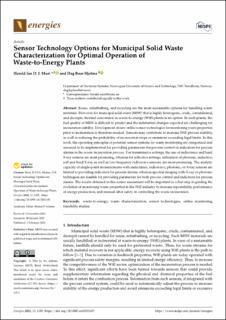| dc.description.abstract | Reuse, refurbishing, and recycling are the most sustainable options for handling waste materials. However, for municipal solid waste (MSW) that is highly heterogenic, crude, contaminated, and decrepit, thermal conversion in waste-to-energy (WtE) plants is an option. In such plants, the fuel quality of MSW is difficult to predict and the substantial changes expected are challenging for incineration stability. Development of new online sensor technologies for monitoring waste properties prior to incineration is therefore needed. Sensors may contribute to increase WtE process stability, as well as reducing the probability of incineration stops or emissions exceeding legal limits. In this work, the operating principles of potential sensor systems for waste monitoring are categorized and assessed to be implemented for providing parameters for process control or indicators for process alarms in the waste incineration process. For transmissive settings, the use of inductance and hard X-ray sensors are most promising, whereas for reflective settings, utilization of photonic, inductive, soft and hard X-ray, as well as low-frequency radiowave sensors, are most promising. The analytic capacity of single-point measurements with inductance, radiowave, photonic, or X-ray sensors are limited to providing indicators for process alarms, whereas spectral imaging with X-ray or photonic techniques are feasible for providing parameters for both process control and indicators for process alarms. The results obtained in this sensor assessment will be important as a first step in guiding the evolution of monitoring waste properties in the WtE industry to increase repeatability, performance of energy production, and manual labor safety in controlling the waste incineration. | en_US |

